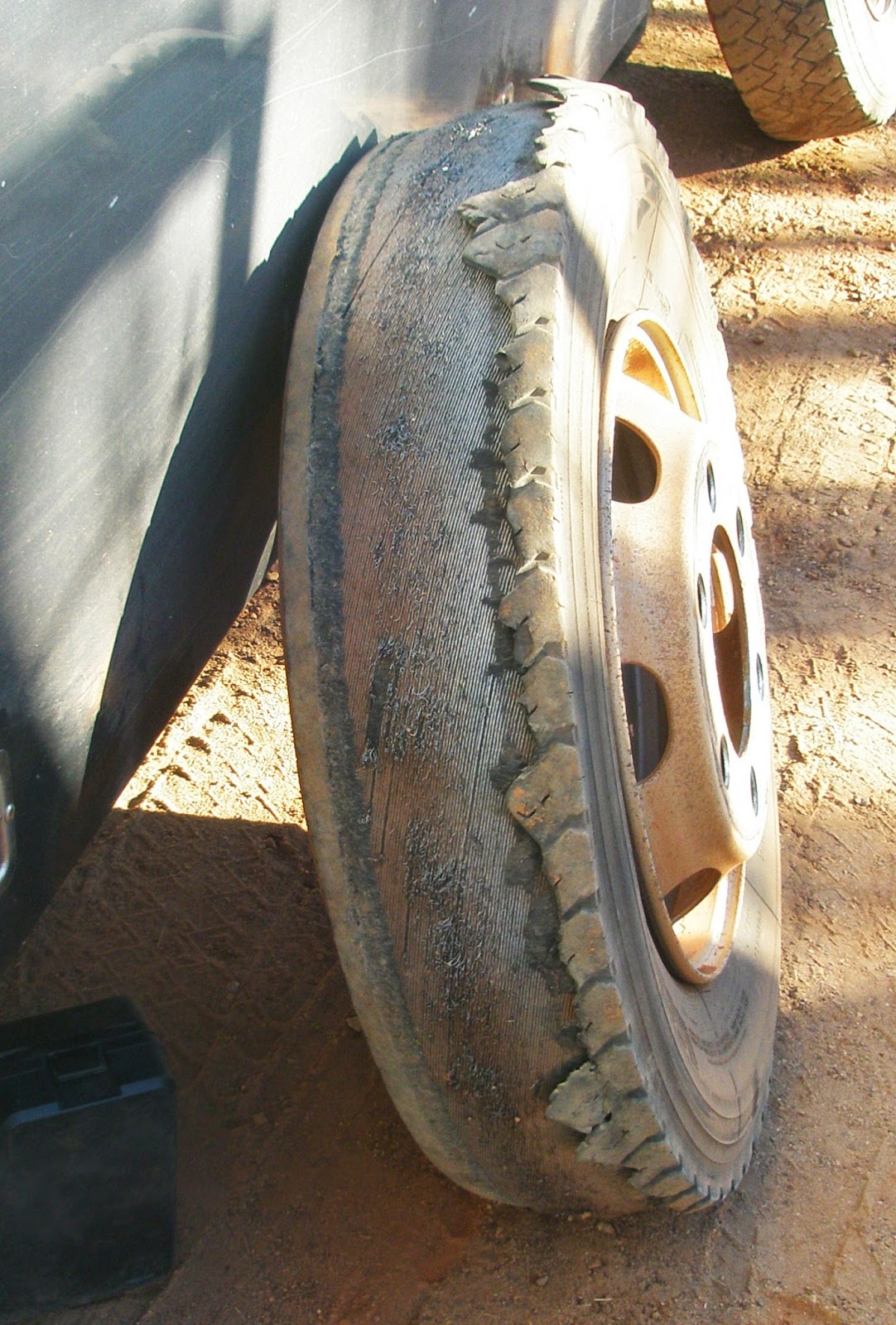 |
| A postcript to the previous post from Halls Creek: This is the truck tyre we blew out on the Tanami Track. |
We’re having a glorious holiday in Broome, an enforced break
in fact as we are waiting for two new batteries to arrive from Sydney . . . and
that could take seven to nine days from today, July 28.
We had made a mad dash from Halls Creek last Friday, July
25, as we were determined to get our power problem sorted.
At least the 700+ km was on bitumen roads and we had phoned
ahead to secure a place in a rather nice caravan park, where we could plug into
240v power, with the option of extending our three-day stay if repairs took longer.
The diagnosis by the auto electrician on Saturday was that one of our two ‘house’
batteries had collapsed, meaning the other needed replacing as well.
We were lucky that near us in the caravan park was an electrical
engineer from the Blue Mountains, waiting on repairs to his vehicle
transmission, and through lots of informal chat, he provided John with a
thorough grounding in matters electrical, particularly concerning batteries.
So today, when John saw the auto electrician again he was
much more informed and knew what was needed. The guy concurred, but the new gear
had to be ordered from Sydney, and has to come by road transport.
We now know that even when not using the motorhome, it
should be kept plugged into 240v power so the batteries do not deteriorate . .
. so we’re never too old to learn something new.
 |
| One of the giant boab trees in the grounds of the courthouse, where weekend markets are held. |
On the bright side, there are a lot worse places in which to
take an enforced break. We love Broome and its atmosphere, even though it is
over run with tourists at present, most of them in caravans or motorhomes,
camper trailers or campervans.
All sorts of places have opened up overflow caravan space,
including one of the local churches and the local pistol club.
We’ve been exploring with the help of a rental car . . .
which we’ve now extended for another period, as we have our stay in the caravan
park. It is so busy they will have to move us twice in the next week and a bit,
but that’s no real problem.
 |
The almost impossible aqua of the water at Broome's
Town Beach.
|
When I phoned to hire a car, I was met with hollow laughter
from most firms as all their cars were spoken for, but one had just one
available the next morning, a three-door manual Hyundai Getz. When we got into
it we found the passenger-side visor had lost its spring and flopped down all
the time. We went back in, reported it and they had a scurry around, deciding they could substitute the vehicle later that
day.
When the call came, they’d upgraded us to a brand-new
automatic i30 which is gorgeous, but after a month in the cab of the Isuzu
truck, it feels like getting down into a sports car.
We are eking out our pleasures, making sure we have
something new to do each day without getting Broomed out. We’ve been pearl
shopping (for my big birthday next January); enjoyed breakfast at the weekend
markets, met lots of locals and loved the ambience; learnt about the pearling
industry past and present; and will go by seaplane and then fast boat through
the horizontal waterfalls north of here on Friday.
We’ve promised ourselves sunset drinks at Cable Beach (a
local institution), a walk on the port wharf, and just generally pottering
around. The caravan park has a superb swimming pool so that’s where you’ll find
us each afternoon.
After a month of driving more than 5000km, with our only
real stop three days at Bedourie, this is proving a real holiday. The weather
is hot, the watermelon is icy cold, as is the wine and beer, so what more could
we want?

.JPG)
.JPG)


.JPG)
.JPG)
.JPG)
.JPG)
.JPG)
.JPG)
.JPG)
.JPG)
.JPG)
.JPG)
.JPG)
.JPG)
.JPG)
.JPG)
.JPG)
.JPG)
.JPG)
.JPG)
.JPG)
.JPG)
.JPG)
.JPG)
.JPG)
.JPG)




